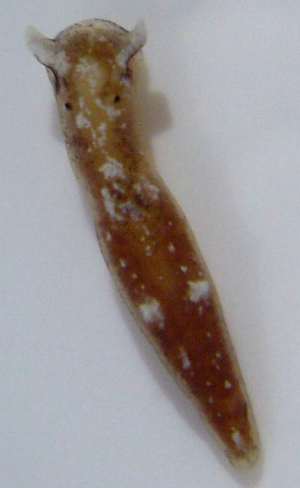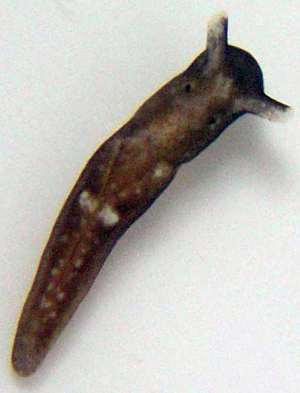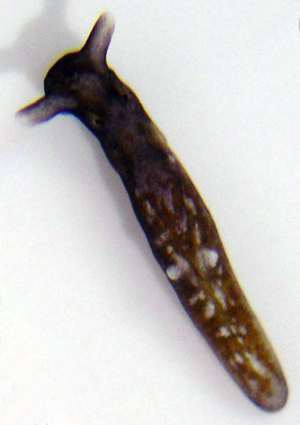

Elysia serca
Marcus, 1955
Order: SACOGLOSSA
Superfamily: ELYSIOIDEA
Family: Elysiidae
DISTRIBUTION
West Atlantic from Florida to Brazil
PHOTO
Great Exuma, Bahamas, Western Atlantic. Depth: 1m. February 03, 2004, on sea grass Halodule wrightii. Upper: 5mm, Lower: 4mm. Photos: Marina Poddubetskaia
This is a small elysiid, growing to about 8 mm in length. The head is proportionally large for an elysiid and the parapodia somewhat reduced. The species was originally described from Brazil and the colour ranges from brown to green with a charcteristic pattern of three whitish patches, one just in front of the heart, and one midway along the free edge of each of the parapodia. Later observations suggest it ranges from green to dark brown, if not black, and as well as the typical 3 white spots there can be other white spots on the parapodia and body. Jensen (1982) revised the species on the basis of material from Florida and considered that E. clena Marcus & Marcus, 1970, from Curacao, was a synonym. One characteristic of this species is the shape of the radular teeth in which the cusp is bent almost at right angles to the base. marcus described the teeth of E. serca as being roughly denticulate, while in E. clena the smaller teeth were denticulate and the larger ones were smooth. Jensen found that in Florida populations the presence of denticles was variable. Marcus (1955) found specimens on brown algae and Ulva and Hosoe (1956) reported it feeding on Ulva. However, Jensen (1982) and Clark (1975) report it feeds on sea grasses such as Halophila, Halodule wrightii and Thalassia.
Jensen suggests that Elysia catulus (Gould, 1870) which is found on the Atalntic coast of Nth America, north of Florida, and feeds on the sea grass Zostera, is possibly an older synonym.
References:
• Clark, K.B. (1975) Nudibranch life cycles in the northwest Atlantic and their relationship to the ecology of fouling communities. Helgolander wiss. Meeresuntersuchungen, 27:, 28-69.
• Hosoe, K. (1956): Notas biol¢gicas sobre Elysia serca Marcus, 1955. Universidade de Sao Paulo Contribuicoes Avulsas do Instituto Oceanografico 2, 1-6.
• Jensen, K.R. (1982) Occurrence of Elysia serca Marcus in Florida, with notes on the synonymy and biology of the species. Journal of Conchology, 31: 87-94.
• Jensen, K.R. (1983) Further note on the ecology and systematics of Elysia serca Marcus (Opisthobranchia, Ascoglossa). Journal of Molluscan Studies, Suppl. 12A: 69-72.
• Marcus, Er. (1955) Opisthobranchia from Brazil. Boletim da Faculdade de Filosofia, Ciencias e Letras. Universidade de Sao Paulo, Zoologia 20: 89-261. (Pls. 1-30)
• Marcus, Ev. (1972) Notes on some opisthobranch gastropods from the Chesapeake Bay. Chesapeake Science, 13(4): 300-317.
• Marcus, Ev (1980): Review of western Atlantic Elysiidae (Opisthobranchia Ascoglossa) with a description of a new Elysia species. Bulletin of marine Science, 30(1): 54-79.
Rudman, W.B., 2004 (March 8) Elysia serca Marcus, 1955. [In] Sea Slug Forum. Australian Museum, Sydney. Available from http://www.seaslugforum.net/find/elysserc
Related messages
Re: Elysia serca
March 22, 2004
From: Kathe R. Jensen
Dear Bill, Marina, Skip, and others,
Now I have finally got around to answering the Elysia serca / catulus questions [#12446]. There was one of my old papers that I could not locate in all my old piles of reprints and it has been more than 20 years since I worked with these animals, so I have to refresh my memory.
Concerning the feeding of E. serca / catulus, Marina's photo of the animal on Halodule [#12446] illustrates very well the feeding track. Halodule has very small epidermal cells and much bigger mesophyll cells. E. serca penetrates right through the epidermal cells and sucks cytoplasm from the mesophyll cells (which have few chloroplasts - or none?). Also, they empty more than one epidermal cell for each tooth penetration - including some in front of the mouth. The dark purple/brownish track is the "emptied" cells (which must still contain some sort of chemical that change colour when the chloroplast containing cytoplasm has been removed).
The animals look pale/starving because they cannot retain chloroplasts. I think this is because seagrass chloroplasts are not as robust as those of "siphonalean" algae. In our chloroplast symbiosis survey paper we had to measure C-14 uptake per animal because there was so little chlorophyll in these animals that we could not measure on a chlorophyll basis. We also found high levels of "dark-fixation", and thus no net photosynthesis.
The teeth of E. serca/catulus are rather strange in having a very tall base. I think that this is because they need to penetrate more than one cell wall at a time on a flat substrate. They prefer Halophila because this seagrass has only two layers of cells, both containing chloroplasts. The pharynx is shaped similar to that of Elysiella pusilla with a very thick layer of muscles surrounding the ventral limb of the radula. This would give added force to the leading radular tooth.
Unfortunately my observations on all this are spread in several publications - some of this due to referees' comments, but some due to me only gradually figuring out the feeding mechanism.
Information is found in the following publications:
• Jensen, K.R. 1982. Occurrence of Elysia serca Marcus in Florida, with notes on the synonymy and biology of the species. Journal of Conchology, 31: 87-94
• Jensen, K.R. 1983. Factors affecting feeding selectivity in herbivorous Ascoglossa (Mollusca: Opisthobranchia). Journal of experimental and marine ecology, 66: 135-148.
• Jensen, K.R. 1983. Further notes on the ecology and systematics of Elysia serca Marcus (Opisthobranchia, Ascoglossa). J. Moll. Stud. Suppl. 12A: 69-72.
• Clark, K.B., Jensen, K.R. & Stirts, H.M. 1990. Survey for functional kleptoplasty among West Atlantic Ascoglossa (=Sacoglossa) (Mollusca: Opisthobranchia). The Veliger, 33: 339-345.
Best wishes,
Kathe
krjensen@zmuc.ku.dk
Jensen, K.R., 2004 (Mar 22) Re: Elysia serca. [Message in] Sea Slug Forum. Australian Museum, Sydney. Available from http://www.seaslugforum.net/find/12486Thanks Kathe,
Bill Rudman
Re: Elysia serca
March 15, 2004
From: Skip Pierce


Bill
Let me try to confuse this conversation a bit. I do not know Elysia serca other than by name. However, the pictures you recently posted [messages #12391, #12392] look to me like an elysiid that has lost it's symbiotic plastids and not fed in a while, at least not fed on the algae that is the plastid source. I think it is very likely that the color variation in this species (brown to green) is not due to more melanin in the brown slugs (actually it may not be melanin at all, but that's another story), but rather to fewer chloroplasts. It is also possible that the slug in the picture was not eating the Halodule blade - as you said, that is an unusual food source for Elysia spp - but may have been eating whatever was growing on the blade's surface - If it was eating anything at all. I still have no data on the issue, be as we continue to watch E. crispata in our aquaria, when they are not eating the plastid providing algae, I would not be surprised to learn that they are eating bacterial films or diatoms.
Skip
pierce@cas.usf.edu
Pierce, S.K., 2004 (Mar 15) Re: Elysia serca. [Message in] Sea Slug Forum. Australian Museum, Sydney. Available from http://www.seaslugforum.net/find/12446Hi Skip,
All contributions welcome - hopefully they will cause students to realise how little we know and inspire a few of them to look more deeply.
I agree they all look a bit 'empty' but I think Kathe Jensen was comparing them with the northern animal, Elysia catulus, which is very black. Concerning them feeding on sea grasses, I too was doubtful because I remember finding that Haminoea zelandiae, which was thought to feed on sea grasses, was in fact scraping the algal/diatom film off the leaves. I have included a couple of close-ups from Marina Poddubetskaia's photos #12393 which show quite noticeable scrape marks on the sea grass leaf. However these could have been made but something else. What I don't understand is how they do the scraping or feeding of any sort, as their tooth is still a typical piercing sacoglossan tooth. Both Elysia serca and Elysia catulus are usually found on sea grass leaves, which would suggest some sort of association. It is puzzling however that Marcus' original description of the species, from Brazil Marcus, 1955) notes 6 brown specimens from 'Phaeophycaea' [= brown algae] and 30 green ones from Ulva. Hosoe (1956) later reported that it fed on Ulva. However Kathe Jensen's studies (1983) showing that it prefers certain sea grasses seem pretty convincing, even if the ingested chloroplasts were not identified.
• Jensen, K.R. (1983) Further note on the ecology and systematics of Elysia serca Marcus (Opisthobranchia, Ascoglossa). Journal of Molluscan Studies, Suppl. 12A: 69-72.
It is certainly an interesting puzzle
Best wishes
Bill Rudman
Elysia serca from Bahamas - pale form
March 12, 2004
From: Marina Poddubetskaia


Dear Bill,
In the Southern Bahamas I discovered a new [to me] Elysia species. All the specimens were tiny and I could clearly separate them into a pale or a dark colour form. I called them Elysia sp.1 and sp.2, just in case they could be two different species. But they were found in one same place and they seem to feed on the same alga (see my next message [#12392]).
I wrote to Kathe Jensen to have her opinion. Her answer was very interesting and full. Here is an extract :
I think I have an ID for Elysia sp. 1 and 2. In fact I am pretty sure they are the same species ... Many years ago I synonymized 2 of Marcus' species, Elysia serca and E. clena, and this is what I think you have here. They feed on seagrasses, and I think that the seagrass on your pictures is Halodule wrightii. So the name should be Elysia serca ..."
Date: February 03, 2004
Location: Great Exuma, Bahamas, Western Atlantic. Site: Stocking Island, Hole n°2. Depth: 1m. Upper: 5mm. Lower: 7mm
Photos: Marina Poddubetskaia - Nembro website
Cordially,
Marina.
nembro@nembro.info
Poddubetskaia, M., 2004 (Mar 12) Elysia serca from Bahamas - pale form. [Message in] Sea Slug Forum. Australian Museum, Sydney. Available from http://www.seaslugforum.net/find/12391Thanks Marina,
These little sea grass-eating species are a very interesting sacoglossan adaptation. I agree with Kathe's synonymy of E. serca and E. clena but can't see any reason why the third species, E. catulus isn't included as well. Elysia chlorotica would seem to have a similar geographical distribution down the Atlantic coast of the Americas so it would not be that strange from the Elysia catulus to do the same.
Best wishes
Bill Rudman
Elysia serca from Bahamas - dark form
March 12, 2004
From: Marina Poddubetskaia

Dear Bill,
To complete my previous message [#12391] about Elysia serca, here are the photos of the dark colour form of this species.
Kathe Jensen wrote:
"There is a slight possibility that the darker coloured specimens are E. catulus which is found further north (Connecticutt to Chesapeake Bay). This species also feeds on seagrasses, and is very similar to E. serca (and may actually be the same species too) ... The dark pigmentation is probably one gene, which is either present or not."
Date: February 03, 2004
Location: Great Exuma, Bahamas, Western Atlantic. Site: Stocking Island, Hole n°2. Depth: 1m. Size: 4-5mm.
Photos: Marina Poddubetskaia - Nembro website
Cordially,
Marina.
nembro@nembro.info


Thanks Marina,
As I said before, it seems very likely that E. catulus is the oldest name for a single species which lievs all down the Atlantic coast of Nth and Sth America.
Best wishes
Bill Rudman
Elysia serca from Bahamas - food plant
March 12, 2004
From: Marina Poddubetskaia


Dear Bill,
Here are the photos of the alga on which I found the pale and dark Elysia serca [messages #12391, #12392]. Kathe Jensen identified it as Halodule wrightii.
Date: February 03, 2004
Location: Great Exuma, Bahamas, Western Atlantic
Site: Stocking Island, Hole n°2
Depth: 1m
Animal's size: 4mm
Photos: Marina Poddubetskaia - Nembro website
Cordially,
Marina.
nembro@nembro.info
Poddubetskaia, M., 2004 (Mar 12) Elysia serca from Bahamas - food plant. [Message in] Sea Slug Forum. Australian Museum, Sydney. Available from http://www.seaslugforum.net/find/12393Thanks Marina,
This food plant is a sea grass, not an algae, which is a very rare ocurrence for the sacoglossans which almost always feed on algae.
Best wishes
Bill Rudman
